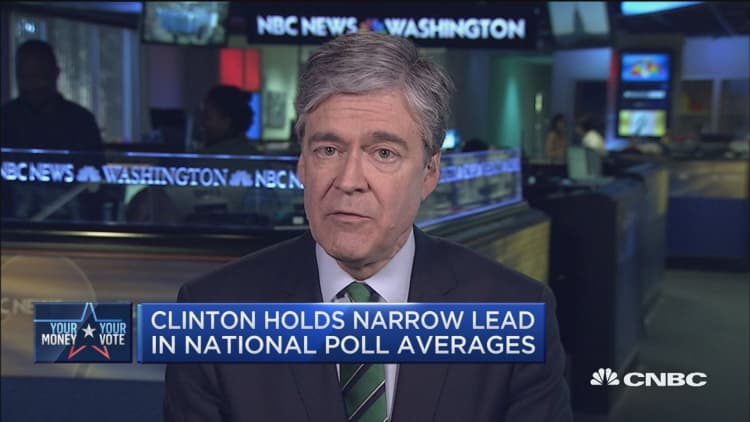
The 2016 presidential campaign, which enters its final weekend with Hillary Clinton leading Donald Trump, has challenged conventional understanding in two significant ways — both of which add uncertainty to Tuesday's outcome.
The first flows from the extraordinary unpopularity of, and frequency of unflattering news about, both major party nominees.
Overall views of Clinton and Trump have remained fixed and negative in NBC News/Wall Street Journal polls all year. They weigh down either's ability to expand their support very much. And the recurrent negative headlines about them — regarding everything from sexual assault to email — discourage even voters who already support them.
One consequence of that is swings in the polls that have less to do with changing voter preferences than with the propensity of either candidate's supporters to respond to calls from pollsters. The less willing they are to respond, the more poorly their preferred candidate does in the survey. This factor partly explains swings in the ABC News/Washington Post tracking poll, which over two weeks moved from a 12-point Clinton lead to a one-point Trump lead and back to a three-point Clinton edge again.
"There's response bias for Trump and against us — like there was response bias for us after the debates," a top Clinton strategist told me. But the strategist added that "things have improved a bit in the last two days," returning the race to the modest advantage Clinton enjoyed two weeks ago.
The second shift concerns the relationship between national polling and prospects for the candidates in the electoral college, the results of which actually determine the outcome. In past elections, because political preferences were distributed fairly evenly across decisive battleground states, national polls served as a valuable proxy for electoral college outcomes. A candidate leading the popular vote by virtually any margin seemed assured of an electoral majority.
Then Al Gore won the 2000 popular vote but lost the presidency to George W. Bush. And now, 16 years later, continuing polarization by education, race and income has shifted the balance.
Trump's strongest appeal lies among white voters without college degrees. His best chances of winning states that President Barack Obama carried in 2008 and 2012 lies in those with above-average proportions of those voters, such as Ohio and Iowa.
At the same time, Clinton has shown above-average appeal to both college-educated whites and Hispanics alienated by Trump. Given some large key states where such voters are concentrated, that means the Democratic nominee is padding her national popular-vote total in ways that won't win her any more electoral votes.
In California, for example, she now leads Trump by a greater margin than Obama defeated Mitt Romney by in 2012. In Texas, with its large Latino constituency, she's running closer to Trump than Obama ran in losing it to Romney. It won't help her in the electoral college because she would be winning California, and losing Texas, even without those extra votes.
"The national polls are really meaningless at this juncture," a senior Trump strategist told me. "Once we are within three points, we can win over 270 (electoral votes) because of her over-performance in Democratic states, and our winning but still under-performing in GOP states like Texas."
Clinton's national lead appears to be roughly three points. She continues to lead in enough battleground states to reach the 270 electoral votes needed for victory. But those leads are tenuous enough that, more than in past races with similar national polling, Trump still has a chance.
And even if he can't close the gap, Clinton could end up with a larger popular vote lead than Obama's four-point 2012 margin, but fewer electoral votes than Obama's 332.
The Clinton strategist projected that she would be elected as America's first woman president with an electoral total of between 300 and 310. If she wins all the states Obama did four years ago, except for Ohio and Iowa, she would end up at 308.


